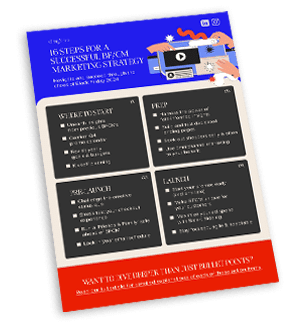Almost there!
Please fill in your email address to access our guide.

Read <imajery>’s digital marketing holiday guide for agencies and brands! Use our expert strategies & tactics for a successful Black Friday 2024.
Read <imajery>’s digital marketing holiday guide for agencies and brands! Use our expert strategies & tactics for a successful Black Friday 2024.
Another year, another upcoming BFCM! 2023 was record-breaking & we hope our 2023 top tips were helpful. While 2024 has presented retail challenges, we expect consumer demand to rebound strongly in Q4 as consumers look to treat their loved ones and themselves.
As a Marketer or retailer, this will be your most hectic period of the year, compounded by exorbitantly high revenue expectations. Thus, we've built a comprehensive 16-step checklist to help you plan, navigate, and succeed through the chaos. We recommend reading through all of them, but feel free to use the quick links below to jump to a specific detailed step.
- Unearth Insights from Previous BFCMs
- Confirm Q4 Promo Calendar
- Revisit Yearly Goals & Budgets
- Kickoff Planning
- Harness the Power of Data-Informed Insights
- Build Dedicated Landing Pages
- Prospect Early & Often
- Embrace Omnichannel Marketing
- Challenge Status Quo on Creative
- Revisit Your Checkout Experience
- Run a 'Friends & Family' Sale
- Email & SMS Segmentation is Key
- Start Early, End Late
- Make Black Friday & Cyber Monday Unique
- Maximize Your Ad Spend with Smart Bidding
- Lock In, Stay Agile & Adapt
1. Unearth Insights from Previous BFCMs
Dust off your post-mortem and review: What worked? What didn't? Why? Leading causes that impacted results are:
- Insufficient Budgets: A low budget can limit audience building before your Black Friday marketing campaign goes live, leading to missed revenue during the BFCM event. Solve for a profitable total ROAS (alt: ecom+omni ROAS or MER) ahead of time and consider uncapping budgets.
- Unprepared website: Missing dedicated landing pages for pipeline-building opportunities and the BFCM weekend can lead to a below-average conversion rate.
- No prospecting efforts: Starting too late (i.e. October) can lead to missed audience-building opportunities as consumers are starting research as early as August.
- Low or infrequent cross-team collaboration: Paid, email, social, content & web/dev teams need to be unified around a singular goal to avoid missed opportunities that negatively impact your ecommerce digital marketing strategy.
2. Confirm Q4 Promo Calendar
Map out the key dates and events for the holiday season, not just Black Friday weekend. These dates include Cyber Monday, Thanksgiving (if applicable in your market), and any other promotional periods you'll be running. A clear calendar helps you plan and manage resources effectively.
3. Revisit Yearly Goals & Budgets
2024 has presented a challenging retail environment in Canada, yet Black Friday isn't the time for timid goals. Set ambitious revenue targets, aim for substantial conversion rate increases, and strive to acquire a wave of new customers. The Canadian market has potential, so push it to the limits. But remember, while your goals should be bold, they must also be realistic and grounded in your historical data and market trends.
4. Kickoff Planning
Gather your marketing team and brainstorm. Now is the time to get creative and explore new ideas while staying aligned with your brand strategy. This brainstorming session should aim to achieve the following:
- Set overall objectives.
- Brainstorm your audience building, pre-sale tactics & experimentation for Q3 & Q4.
- Identify the ad channels and/or external marketplaces you'll be supporting through Q4.
- Determine the assets you need to succeed during Black Friday online, including ad copy, creative, landing pages, tracking, reporting & external buy-in.
⏸️ Pause! Have you not yet started the above, or does it seem overly daunting? Consider a free marketing audit and learn how <imajery> can help your business grow!
5. Harness the Power of Data-Driven Informed Insights
Having a strong measurement & reporting foundation is integral to your 2024 Black Friday strategy. As marketers, we have plenty of options, and it’s important not to fall guilty to paralysis by analysis. Plan a clear-cut process!
- Utilize GA4 to unlock cross-channel reporting & review pipeline trends or deficiencies.
- Supplement with platform attribution (i.e. Google Ads, Meta Ads) & measure for incremental total revenue lift in GA4. Measure & optimize your prospecting efforts towards non-revenue KPIs (i.e. cost-per-video view, cost-per-add to cart, cost-per-product view) for powerful audience-building capabilities.
- Build clear and actionable reporting using your favourite dashboard (we prefer pairing Supermetrics BigQuery with Looker Studio).
6. Build Dedicated Landing Pages
Build & test explorative landing pages to support your pre-sale initiatives & remain seasonally relevant, and highlight top & trending products. Optimal landing pages will drive incremental conversion rate, AOV & thus revenue. A few starter ideas are below:
- Prospecting: Build gift guides, product, or collection-focused landing pages. Leverage customer testimonials to build customer trust.
- BFCM event pages: Create urgency with countdown timers, highlight best sellers, top reviewed, and limited-time/quantity discounts. Selectively test cross-sell & post-sell offers with engaged shoppers.

Tip: Consider having your dedicated product listing pages sorted by highest discount or lowest price by default to capture BFCM's value-based focus, especially considering the current economic environment.
7. Prospect Early & Often
Don't wait for shoppers to come to you – seek them out proactively. Start your Black Friday prospecting efforts before November. Utilize social media ads (Meta Ads), Google Search campaigns, and display advertising to capture potential customers' attention early in their decision-making process. Set specific non-revenue-based KPIs to ensure the campaigns aren't deprioritized for low-funnel revenue drivers. Some of our favourite paid media audience builders include:
- Meta Ads lead generation to bulk up your email & SMS subscriber list
- Video views campaign with a dedicated remarketing funnel
- Google non-brand search campaigns to a dedicated landing page
- Brand & influencer-based partnerships to extend your reach to new audiences
Pro-tip: Consider minimizing your brand search & shopping budget during late Q3 & early Q4 while building pipeline audiences. If done, measure against organic's ability to capture traffic & the aggressiveness of competition.
8. Embrace Omnichannel Marketing
Beyond ensuring a seamless buy-online & pick-up in-store (BOPIS) website experience, extending your online measurement to include offline impact can be a powerful tool to communicate increased returns. Attempt to collect customer information during their purchase, and while perfect attribution does not exist, take advantage of these tactics:
- Google Ads: Modelling store visits & store sales can be tied back to ad clicks.
- Meta Ads: Importing offline data (using customer information) can match user profiles and measure who clicked an ad.
- Coupons: Allowing users to sign up online and redeem in-store can give you valuable insights into your marketing effort's ability to drive customers in-store.

9. Challenge Status Quo on Creative
Black Friday is your opportunity to make a bold statement. Refresh your product photos, website banners, and promotional videos with eye-catching visuals that capture the season's spirit. Iterate on your successful creative testing (you ran creative testing during the year, right?) to capture user attention in 3 seconds or less and maximize your CTR. For best creative practices, read our Ultimate Graphic Designer’s Guide to Direct Response Ads.

10. Revisit Your Checkout Experience
Paired with a mobile-first checkout experience, ensuring your users have a quick & frictionless checkout experience will avoid lost sales. Focus points:
- One-click checkout experience: Offering Apple Pay, Google Pay, and Shop Pay enables users to auto-complete details and finish their purchases quickly.
- (BNPL) Buy Now, Pay Later Apps (i.e. Klarna, Sezzle): Providing flexibility in tough economic times, select customers will appreciate having additional time to pay off their purchase & these tools have proven to drive incremental AOV. Speak with your BNPL provider to explore if you can extend the interest-free payment period, providing customers additional repayment flexibility & extending purchasing power.
- Guest Checkout or Social Login: Avoiding tedious sign-up flows is essential as consumer attention is fleeting, every second counts during Black Friday!
11. Run a 'Friends & Family' Sale
What better way to test the steps above than with a "warm-up" sale in late August-early October? We recommend making the promo as aggressive as possible (but leave something special for BFCM). This will allow you to gain early insights into your promotional planning, early prospecting efforts, potential email schedules, and stress-testing your dedicated landing pages & checkout flow for further refinement.
12. Email & SMS Segmentation is Key
Identify critical segments, such as high-value customers, category-specific shoppers & dormant subscribers, while solidifying your email schedule. Ensure subscribers benefit from being subscribed (i.e., early access, bonus discount, gift with purchase). Email frequency is high during November as consumers are bombarded with emails, so adjust your plan accordingly and test sending at a higher frequency to ensure your emails don't get lost in the promotions tab. Never stop testing either: send times, subject lines, template variations & landing pages should remain active throughout November.
Tip: In a world of increasing consumer transparency, consider sending a message to subscribers ahead of Black Friday notifying them of increased activity and providing an option to reduce (i.e. 1x/day plus exclusive offers only).
13. Start Early, End Late
No longer a secret, starting your promotions early in November offers advantages. You can get valuable data into new campaigns & assets ahead of an increasingly competitive period. Consider launching enticing discounts starting November 1, plus pair with the next step for maximal impact! Additionally, Holiday shopping doesn't end after Cyber Monday; continue promotional efforts until your Holiday shipping deadlines to maximize conversion rates.
14. Make Black Friday & Cyber Monday Unique
Paired with the above, make Black Friday/Cyber Monday memorable for users. Limited-time discounts, doorcrashers (online or offline), and bonus discounts are all effective ways to drive incremental sales and re-engage audiences who didn't purchase during earlier sales.

15. Make Your Spend Go Further With Smart Bidding
Platforms like Google Ads and Facebook Ads offer smart bidding strategies that leverage machine learning to optimize your ad campaigns. Utilize these tools to automate your bidding process and ensure your ads reach the right audience at the right time, maximizing your return on investment.
- Meta Ads: Consolidate your campaigns & audiences (or run Advantage Shopping+) campaigns to get out of learning quickly given the short duration of promotions.
- Google PMax: Implement the PMAX insights script (shoutout to Mike Rhodes) to better understand your placement delivery ahead of Black Friday and track how your bidding adjustments impact the campaign.
- Google PMax: Aim to make final tROAS/tCPA adjustments one week before Black Friday and leverage seasonal bid adjustments for further refinement. Ideally, budgets should stay within 25% daily increases.
Do you need a PMax refresher? Check out our five learnings from 1 year of PMax for ecommerce blog.
16. Lock In, Stay Agile and Adapt
Black Friday is a dynamic environment, so it's best to reduce your call schedule and be ready to make changes. Be prepared to pivot your strategies based on real-time data and market trends. If a promotion isn't resonating with your audience, adjust your messaging or try a different approach. Flexibility is critical to success in the fast-paced world of Black Friday marketing.
Phew, you made it! We hope the above inspires your best-performing Canadian Black Friday 2024 marketing strategy yet. If you have any questions or want to discuss a specific point in more depth, comment below or reach out to us directly at info@imajery.com.
Author

Director of Paid Media
Interested in working with Us?
We'd love to hear from you!
